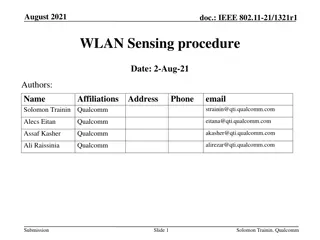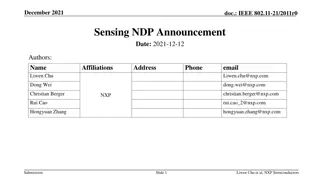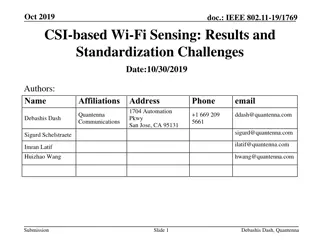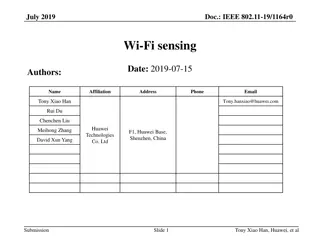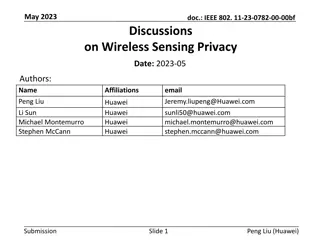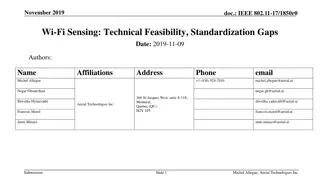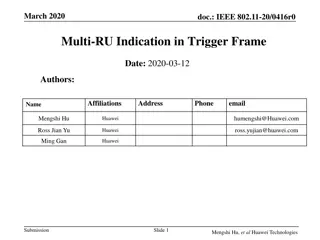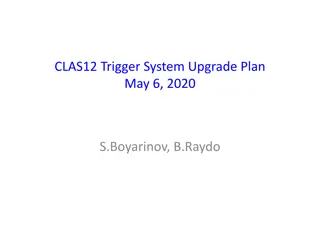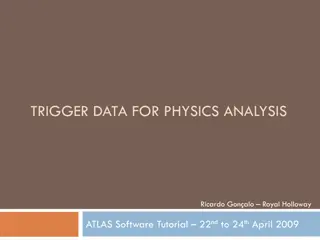Comparison of Trigger-based vs. Non-Trigger-based Sensing Measurement in IEEE 802.11
The document discusses the differences between Trigger-based (TB) and Non-Trigger-based (Non-TB) sensing measurement instances in IEEE 802.11 standards, focusing on who initiates the sensing measurement. TB sensing is initiated by the AP, while Non-TB sensing is initiated by a non-AP STA, enabling on-demand sensing between the non-AP STA and the AP responder. Various assumptions and scenarios are explored to highlight the advantages of each approach.
Download Presentation

Please find below an Image/Link to download the presentation.
The content on the website is provided AS IS for your information and personal use only. It may not be sold, licensed, or shared on other websites without obtaining consent from the author. Download presentation by click this link. If you encounter any issues during the download, it is possible that the publisher has removed the file from their server.
E N D
Presentation Transcript
doc.: IEEE 802.11-21/1433r2 September 2021 Non-TB sensing measurement Date: 2021-09-27 Authors: Name Affiliations Address Phone Email Cheng Chen cheng.chen@intel.com Dibakar Das dibakar.das@intel.com Intel Carlos Cordeiro carlos.cordeiro@intel.com Submission Slide 1 Cheng Chen, Intel
doc.: IEEE 802.11-21/1433r2 September 2021 Motivation and background 11bf has defined the Trigger-based sensing measurement instance. It starts with the polling phase, where the AP polls STAs that are supposed to participate in the following TF sounding and/or NDPA sounding. So basically, this is mostly an AP-initiated measurement flow. TB sensing measurement instance works well in scenarios where: An AP is the initiator. A non-AP STA is the initiator, and the AP already knows all the sensing schedules and parameters, for example, through sensing negotiation with the STA initiator [1]. In [1], we also presented the Non-TB sensing measurement instance where the measurement instance is initiated by a non-AP STA. We propose the Non-TB sensing measurement to enable scenarios where a non-AP STA is the initiator, and sensing occurs in an on-demand manner between the non- AP STA initiator and the AP responder. Similar ideas were presented in [2][3]. In this contribution, we continue discussions on the Non-TB sensing measurement instance. Slide 2 Submission Cheng Chen, Intel
doc.: IEEE 802.11-21/1433r2 September 2021 TB vs. Non-TB sensing measurement instance The key difference between TB and Non-TB sensing measurement is who initiates the sensing measurement. In TB sensing measurement, the AP initiates the flow by polling the STAs to check the availability, which is necessary because: Some of the STAs may be unassociated, in which case the AP has no knowledge of the STAs and has to check the availability of them before the TF and/or NDPA sounding. Even if the STAs are associated to the AP, they may go to power save and therefore the AP still needs to check the availability of them before the TF and/or NDPA sounding. In Non-TB sensing measurement, the non-AP STA initiates the flow and directly goes into the sounding with the AP. The non-AP STA can safely assume the AP is there as long as it obtains a TXOP. Slide 3 Submission Cheng Chen, Intel
doc.: IEEE 802.11-21/1433r2 September 2021 Assumptions In this contribution, we make the following assumptions We assume the non-AP STA initiator is either associated to the AP or has already established security context with the AP in an unassociated state. We only consider the scenario where there is a single AP responder in one measurement instance Of course, the non-AP STA can always establish multiple sensing sessions with multiple AP responders, but generally it can only talk to one AP responder in one measurement instance. If there are additional non-AP STA responders in addition to the AP responder, we think the TB sensing measurement instance is a better fit because: A non-AP STA typically cannot support MU functionalities. The non-AP STA initiator will have to rely on the AP for the scheduling, synchronization etc. to coordinate multiple responders. We assume the non-AP STA and the AP has already finished the Session Setup and Sensing Measurement Setup. Submission Slide 4 Cheng Chen, Intel
doc.: IEEE 802.11-21/1433r2 September 2021 Possible scenarios AP STA1 1) Bidirectional sensing Sensing Initiator Sensing Receiver & Transmitter Sensing Responder Sensing Transmitter & Receiver Sensing PPDU transmission AP STA1 2) Unidirectional UL sensing Sensing Initiator Sensing Transmitter Sensing Responder Sensing Receiver AP STA1 3) Unidirectional DL sensing Sensing Initiator Sensing Receiver Sensing Responder Sensing Transmitter Submission Slide 5 Cheng Chen, Intel
doc.: IEEE 802.11-21/1433r2 September 2021 Unified flow to cover all 3 scenarios AP STA1 1) I2R sensing sounding R2I sensing sounding R2I NDP Sensing Feedback AP Sensing Responder Sensing Transmitter & Receiver Sensing Initiator Sensing Receiver & Transmitter Sensing Responder SIFS AP STA1 Sensing NDPA I2R NDP 2) STA1 Sensing Initiator SIFS SIFS Sensing Initiator Sensing Transmitter Sensing Responder Sensing Receiver Different from the scenarios where the initiator is an AP, whenever the non-AP STA obtains a TXOP, it can safely assume the AP responder is always there. So, it can directly go ahead and transmit the NDPA. Depending on the roles of the STA and AP, I2R NDP or R2I NDP may be transmitted with the minimum possible length. The sensing NDPA frame will include the Measurement Setup ID [4], which corresponds to the sensing setup where STA1 and AP understand their roles, The sensing NDPA configures the parameters for both the I2R NDP and R2I NDP. So if the I2R or R2I NDP is transmitted with minimal possible length, it will be indicated in the Sensing NDPA frame. Sensing feedback for the I2R sounding could be sent to STA1 from the AP. AP STA1 3) Sensing Initiator Sensing Receiver Sensing Responder Sensing Transmitter Sensing PPDU transmission Submission Slide 6 Cheng Chen, Intel
doc.: IEEE 802.11-21/1433r2 September 2021 Non-TB sensing measurement instance for scenario 1) I2R sensing sounding R2I sensing sounding Sensing PPDU transmission R2I NDP Sensing Feedback 1) AP AP STA1 Sensing Responder SIFS Sensing NDPA I2R NDP STA1 Sensing Initiator Sensing Initiator Sensing Receiver & Transmitter Sensing Responder Sensing Transmitter & Receiver SIFS SIFS The sensing NDPA frame will include the Measurement Setup ID [4], which corresponds to the sensing setup where STA1 and AP understand their roles. The sensing NDPA configures the parameters for both the I2R NDP and R2I NDP. Sensing feedback for the I2R sounding could be sent to STA1 from the AP. Submission Slide 7 Cheng Chen, Intel
doc.: IEEE 802.11-21/1433r2 September 2021 Non-TB sensing measurement instance for scenario 2) I2R sensing sounding Sensing PPDU transmission R2I NDP Sensing Feedback AP 2) AP STA1 Sensing Responder SIFS Sensing NDPA I2R NDP STA1 Sensing Initiator Sensing Responder Sensing Receiver Sensing Initiator Sensing Transmitter SIFS SIFS The R2I NDP in this scenario is useful in the following aspects: It acts as an acknowledgement from the AP side to confirm the reception of the Sensing NDPA frame and the I2R NDP. It gives more time to the AP to process and transmit the sensing feedback for the I2R NDP measurement. This will also be helpful for the delivery of the power control information for the R2I NDP. It helps to maintain a unified flow similar to the 11az Non-TB ranging flow that has already been implemented in many existing implementations . The sensing NDPA frame will include the Measurement Setup ID [4], which corresponds to the sensing setup where STA1 and AP understand their roles. The sensing NDPA should configure the R2I NDP to be transmitted with minimal possible length. Sensing feedback for the I2R sounding could be sent to STA1 from the AP. Submission Slide 8 Cheng Chen, Intel
doc.: IEEE 802.11-21/1433r2 September 2021 Non-TB sensing measurement instance for scenario 3) R2I sensing sounding Sensing PPDU transmission R2I NDP AP 3) AP STA1 Sensing Responder I2R NDP Sensing NDPA STA1 Sensing Initiator Sensing Initiator Sensing Receiver Sensing Responder Sensing Transmitter SIFS SIFS The I2R NDP in this scenario is useful in the following aspects: It avoids creating a new NDPA+NDP flow where the NDP is SIFS after and is from the recipient of the NDPA frame. If we remove the I2R NDP, the AP may not be able to configure and transmit the R2I NDP in SIFS time. Many AP implementations are not able to support transmitting NDP SIFS after receiving the NDPA. It helps to maintain a unified flow similar to the 11az Non-TB ranging flow that has already been implemented in many existing implementations. The sensing NDPA frame will include the Measurement Setup ID [4], which corresponds to the sensing setup where STA1 and AP understand their roles. The sensing NDPA should configure the I2R NDP to be transmitted with minimal possible length. Submission Slide 9 Cheng Chen, Intel
doc.: IEEE 802.11-21/1433r2 September 2021 Configuration of the I2R and R2I NDP Assume we reuse the format of HE Ranging NDP for the Sensing NDP. The number of HE-LTF symbols in an HE Ranging NDP depends on the number of space-time streams N_STS, the number of LTF repetitions LTF_REP, and, when Secure HE-LTFs with randomized LTF sequence are used, the number of users NUM_USERS. At least 48us minimum. Submission Slide 10 Cheng Chen, Intel
doc.: IEEE 802.11-21/1433r2 September 2021 Conclusions We propose a unified non-TB sensing measurement instance flow which works in scenarios where a non-AP STA is the initiator, and an AP is the responder. The proposed flow of non-TB sensing measurement instance is able to address different scenarios with a unified sequence. The proposed non-TB sensing measurement instance reuses much of existing non-TB ranging flow defined in 11az, and therefore can be easily adapted by many existing implementations without significant changes. Submission Slide 11 Cheng Chen, Intel
doc.: IEEE 802.11-21/1433r2 September 2021 SP Do you agree with the following? 11bf shall define a non-Trigger based (non-TB) sensing measurement instance as follows: One non-AP STA is the sensing initiator and one AP is the sensing responder. Once the non-AP STA obtains a TXOP, it shall initiate a non-TB sensing measurement instance by transmitting an NDPA frame to the AP followed by an Initiator-to-Responder (I2R) NDP SIFS after. SIFS after the I2R NDP, the AP shall transmit a Responder-to- Initiator (R2I) NDP to the non-AP STA. If the non-AP STA is only the sensing transmitter, then the NDAP frame should configure the R2I NDP to be transmitted with minimum possible length with one LTF symbol. If the non-AP STA is only the sensing receiver, then the NDPA frame should configure the I2R NDP to be transmitted with minimum possible length with one LTF symbol. The details of the NDPA frame are TBD. Submission Slide 12 Cheng Chen, Intel
doc.: IEEE 802.11-21/1433r2 September 2021 References [1] DCN0990r2, Discussions on sensing measurement flows [2] DCN0842r0, A channel measurement procedure for WLAN sensing [3] DCN1015r2, Non-TB and TB measurement procedure for WLAN sensing [4] DCN0644r3, Sensing session and measurement exchange identification Submission Slide 13 Cheng Chen, Intel






